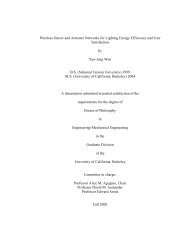Feature dimensionality reduction for partial - Berkeley Expert ...
Feature dimensionality reduction for partial - Berkeley Expert ...
Feature dimensionality reduction for partial - Berkeley Expert ...
Create successful ePaper yourself
Turn your PDF publications into a flip-book with our unique Google optimized e-Paper software.
(2000). There<strong>for</strong>e, LDA attempts to determine the trans<strong>for</strong>mation matrix, W , bymaximizing the Fisher’s criterion function defined as(2000)].T| W SBW|JLDA(W ) = T [Duda et al| W S W|It has been proved that finding W that maximizes JLDA(W)is equivalent to solving ageneralized eigenvalue problem S W = λSW , which yields a maximum of c −1(c isBWthe number of classes) eigenvectors if S w is nonsingular. Those eigenvectorscorresponding to the d largest eigenvalues <strong>for</strong>m the columns of the trans<strong>for</strong>mationmatrix, W .From the above-defined objective functions, we can see that LDA finds new features bymaximizing discriminating power between classes, while PCA attempts to best representthe entirety of the data without paying any attention to the underlying class structure. Asthe result, it is intuitive and generally accepted that <strong>for</strong> classification problems, LDAshould per<strong>for</strong>m better that PCA does. Recently, however, some empirical studies, e.g.,Martinez and Kak (2001), have shown that when the training data set is small, PCA canoutper<strong>for</strong>m LDA. Since LDA requires class in<strong>for</strong>mation <strong>for</strong> all data examples, it is asupervised method. On the other hand, PCA is an unsupervised method.3. A case study: The case studied in this paper is the design of a PD diagnostic system<strong>for</strong> aircraft wiring. It is a part of our multiple-generation initiative project funded byONR. Presented here as an example case study is the initial design of an on-ground, deenergizedprototype system.Experiment test <strong>for</strong> generating PD pulses: PD measurements <strong>for</strong> aircraft wiring aregenerated and recorded through laboratory tests. Damage to wiring insulation generallytakes two <strong>for</strong>ms: material degradation due to aging or thermal/electrical environment, andchafing that may occur during maintenance and mechanical abrasion during operationinducedvibration. The lab tests conducted in this paper focus on the later, i.e., wirechafing. For classifier design purpose, two wiring conditions are tested. One is <strong>for</strong> normalcondition wires and another <strong>for</strong> wires with artificial chafing. Two different ways areconsidered in producing artificial defects. The first type represents defects occurring intwisted pair wires. For that a small piece of the upper insulation layer was removed fromboth wires in the twisted pair. This type of defect is the most reproducible one since thethickness of the remaining insulator layer was not changed. Samples <strong>for</strong> this type wereprepared from two aircraft grade wires, types M22759/90-22-95 and M22759/81-22-52.The second type of defect simulated a chafed wire touching the shielding of the cablebundle or a metal part of the aircraft. The wire was chafed in a short length and a piece oftinned copper wire was twisted around the chafed area. The tinned copper wire was alsopressed into the chafed section in order to touch the remained insulation layer. Suchsamples were prepared from three aircraft grade wires, types M22759/90-22-95,M22759/81-22-52 and M81044/6-22-9.A total of nine wire samples are tested with maximum of 10 repetitions <strong>for</strong> each sample.After data cleansing (including the removal of noise and incomplete data sets), 596 PDW
















